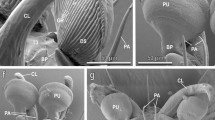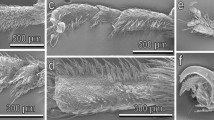Abstract
Species of various insect orders possess specialised tarsal adhesive structures covered by a thin liquid film, which is deposited in the form of footprints. This adhesive liquid has been suggested to be chemically and physiologically related to the epicuticular lipid layer, which naturally covers the body of insects and acts as the prime barrier to environmental stresses, such as desiccation. The functional efficiency of the layer, however, is jeopardised by partial melting that may occur at physiological temperatures. In this study, light microscopic images of elytral prints show that the epicuticular lipid layer of the Colorado potato beetle Leptinotarsa decemlineata actually is partially liquid and chemical investigations reveal the high similarity of the epicuticular hydrocarbon pattern and the tarsal liquid. By means of chemical manipulation of the surface hydrocarbon composition of live beetles, the substance exchange between their tarsal adhesive hairs and the body surface is monitored. Histological sections of L. decemlineata tarsi, furthermore, reveal glandular cells connected to individual adhesive setae and departing from these results, an idea of a general mechanism of tarsal secretion is developed and discussed in a functional–ecological context.



Similar content being viewed by others
Abbreviations
- GC–FID:
-
Gas chromatography with flame ionisation detection
- GC–MS:
-
Coupled gas chromatography–mass spectrometry
- i :
-
Methyl branch in hydrocarbons at a position > 8
- IRM:
-
Interference reflection microscopy
- SEM:
-
Scanning electron microscopy
- SPME:
-
Solid-phase microextraction
- T m :
-
Melting point
References
Akino T, Terayama M, Wakamura A, Yamaoka R (2002) Intraspecific variation of cuticular hydrocarbon composition in Formica japonica Motschoulsky (Hymenoptera: Formicidae). Zool Sci 19:1155–1165
Attygalle AB, Aneshansley DJ, Meinwald J, Eisner T (2000) Defense by foot adhesion in a chrysomelid beetle (Hemisphaerota cyanea): characterization of the adhesive oil. Zoology 103:1–6
Bauchhenß E (1979) Die Pulvillen von Calliphora erythrocephala (Diptera, Brachycera) als Adhäsionsorgane. Zoomorphology 93:99–123
Beament JWL (1945) The cuticular lipoids of insects. J Exp Biol 21:115–131
Betz O (2002) Performance and adaptive value of tarsal morphology in rove beetles of the genus Stenus (Coleoptera, Staphylinidae). J Exp Biol 205:1097–1113
Betz O (2003) Structure of the tarsi in some Stenus species (Coleoptera, Staphylinidae): external morphology, ultrastructure, and tarsal secretion. J Morph 255:24–43
Betz O, Kölsch G (2004) The role of adhesion in prey capture and predator defence in arthropods. Arthopod Struct Dev 33:3–30
Betz O, Mumm R (2001) The predatory legs of Philonthus marginatus (Coleoptera, Staphylinidae): functional morphology and tarsal ultrastructure. Arthopod Struct Dev 30:77–97
Beutel RG, Gorb SN (2001) Ultrastructure of attachment specializations of hexapods (Arthropoda): evolutionary patterns inferred from a revised ordinal phylogeny. J Zool Syst 39:177–207
Beutel RG, Gorb SN (2006) A revised interpretation of the evolution of attachment structures in hexapoda with special emphasis on Mantophasmatodea. Arthropod Syst Phylogeny 64:3–25
Bullock JMR, Drechsler P, Federle W (2008) Comparison of smooth and hairy attachment pads in insects: friction, adhesion and mechanisms for direction-dependence. J Exp Biol 211:3333–3343
Carlson DA, Bernier UR, Sutton BD (1998) Elution patterns from capillary GC for methyl-branched alkanes. J Chem Ecol 24:1845–1865
Cassier P, Lensky Y (1995) Ultrastructure of the wax gland complex and secretion of beeswax in the worker honey bee Apis mellifera L. Apidologie 26:17–26
Dani FR, Jones GR, Destri S, Spencer SH, Turillazzi S (2001) Deciphering the recognition signature within the cuticular chemical profile of paper wasps. Anim Behav 62:165–171
Drechsler P, Federle W (2006) Biomechanics of smooth adhesive pads in insects: influence of tarsal secretion on attachment performance. J Comp Physiol A 192:1213–1222
Dubis E, Malinski E, Dubis A, Szafranek J, Nawrot J, Poplawski J, Wróbel JT (1987) Sex-dependent composition of cuticular hydrocarbons of the Colorado beetle Leptinotarsa decemlineata Say. Comp Biochem Physiol A 87:839–843
Eltz T (2006) Tracing pollinator footprints on natural flowers. J Chem Ecol 32:907–915
Federle W, Riehle M, Curtis ASG, Full RJ (2002) An integrative study of insect adhesion: mechanics and wet adhesion of pretarsal pads in ants. Integr Comp Biol 42:1100–1106
Geiselhardt SF, Geiselhardt S, Peschke K (2006) Chemical mimicry of cuticular hydrocarbons–how does Eremostibes opacus gain access to breeding burrows of its host Parastizopus armaticeps (Coleoptera, Tenebrionidae)? Chemoecology 16:59–68
Geiselhardt SF, Geiselhardt S, Peschke K (2009) Comparison of tarsal and cuticular chemistry in the leaf beetle Gastrophysa viridula (Coleoptera: Chrysomelidae) and an evaluation of Solid-phase microextraction and solvent extraction techniques. Chemoecology 19:185–193
Geiselhardt SF, Federle W, Prüm B, Geiselhardt S, Lamm S, Peschke K (2010) Impact of chemical manipulation of tarsal liquids on attachment in the Colorado potato beetle, Leptinotarsa decemlineata. J Insect Physiol 56:398–404
Gibbs A (1995) Physical properties of insect cuticular hydrocarbons: model mixtures and lipid interactions. Comp Biochem Physiol B 112:667–672
Gibbs A (2002) Lipid melting and cuticular permeability: new insights into an old problem. J Insect Physiol 48:391–400
Gibbs A, Pomonis JG (1995) Physical properties of insect cuticular hydrocarbons: The effects of chain length, methyl-branching and unsaturation. Comp Biochem Physiol B 112:243–249
Gorb SN (1997) Porous channels in the cuticle of the head-arrester system in dragon/damselflies (Insecta: Odonata). Microsc Res Tech 37:583–591
Gorb SN (1998a) Frictional surfaces of the elytra-to-body arresting mechanism in tenebrionid beetles (Coleoptera: Tenebrionidae): design of co-opted fields of microtrichia and cuticle ultrastructure. Int J Insect Morphol Embryol 27:205–225
Gorb SN (1998b) The design of the fly adhesive pad: distal tenent setae are adapted to the delivery of an adhesive secretion. Proc R Soc Lond B 265:747–752
Gorb SN (2001) Attachment devices of insect cuticle. Kluwer Academic Publishers, Dordrecht
Gu X, Quilici D, Juarez P, Blomquist GJ, Schal C (1994) Biosynthesis of hydrocarbons and contact sex pheromone and their transport by lipophorin in females of the German Cockroach (Blattella germanica). J Insect Physiol 41:257–267
Hasenfuss I (1977) Die Herkunft der Adhäsionsflüssigkeit bei Insekten. Zoomorphology 87:51–64
Haverty MI, Grace JK, Nelson LJ, Yamamoto RT (1996) Intercaste, intercolony, and temporal variation in cuticular hydrocarbons of Coptotermes formosanus Shiraki (Isoptera: Rhinotermitidae). J Chem Ecol 22:1813–1834
Howard RW, Blomquist GJ (1982) Chemical ecology and insect biochemistry of insect hydrocarbons. Annu Rev Entomol 27:149–172
Howard RW, Blomquist GJ (2005) Ecological, behavioral, and biochemical aspects of insect hydrocarbons. Annu Rev Entomol 50:371–393
Ishii S (1987) Adhesion of a leaf feeding ladybird Epilachna vigintioctomaculta (Coleoptera: Coccinellidae) on a vertically smooth surface. Appl Entomol Zool 22:222–228
Kosaki A, Yamaoka R (1996) Chemical composition of footprints and cuticula lipids of three species of lady beetles. Jpn J Appl Entomol Zool 40:47–53
Lewis CT (1962) Diffusion of oil films over insects. Nature 193:904
Locke M (1961) Pore canals and related structures in insect cuticle. J Biophys Biochem Cytol 10:589–618
Lockey KH (1980) Insect cuticular hydrocarbons. Comp Biochem Physiol B 65:457–462
Lockey KH (1985) Insect cuticular lipids. Comp Biochem Physiol B 81:263–273
Luft JH (1961) Improvements in epoxy resin embedding methods. J Biophys Biochem Cytol 9:409–414
Malinski E, Kusmierz J, Szafranek J, Dubis E, Poplawski J, Wróbel JT, König WA (1986) Cuticular hydrocarbons of the Colorado beetle Leptinotarsa decemlineata Say. Z Naturforsch 41b:567–574
Nelson DR, Sukkestad DR (1970) Normal and branched aliphatic hydrocarbons from eggs of the tobacco hornworm. Biochemistry 9:4601–4611
Nelson DR, Sukkestad DR, Zaylskie RG (1972) Mass spectra of methyl-branched hydrocarbons from eggs of the tobacco hornworm. J Lipid Res 13:413–421
Nelson D, Fatland C, Adams T (2002) Methyl-branched alkanes on the surface of male and female adults, and eggs of the Colorado potato beetle, Leptinotarsa decemlineata. J Insect Sci 2:17
Nelson DR, Adams TS, Fatland CL (2003) Hydrocarbons in the surface wax of eggs and adults of the Colorado potato beetle, Leptinotarsa decemlineata. Comp Biochem Physiol B 134:447–466
Noble-Nesbitt J (1991) Cuticular permeability and its control. In: Binnington K, Retnakaran A (eds) The Physiology of the Insect Epidermis. CSIRO Publications, East Melbourne
Noirot C, Quennedey A (1974) Fine structure of insect epidermal glands. Annu Rev Entomol 19:61–80
Noirot C, Quennedey A (1991) Glands, gland cells, glandular units: some comments on terminology and classification. Ann Soc Entomol 27:123–128
Peschke K (1987) Cuticular hydrocarbons regulate mate recognition, male aggression, and female choice of the rove beetle, Aleochara curtula. J Chem Ecol 13:1993–2008
Pomonis JG (1989) Cuticular hydrocarbons of the screwworm, Cochliomyia hominivorax (Diptera: Calliphoridae). Isolation, identification, and quantification as a function of age, sex and irradiation. J Chem Ecol 15:2301–2317
Pomonis JG, Nelson DR, Fatland CL (1980) Insect hydrocarbons. 2. Mass spectra of dimethylalkanes and the effect of the number of methylene units between groups on fragmentation. J Chem Ecol 6:965–972
Schal C, Sevala VL, Young HP, Bachmann JAS (1998) Sites of synthesis and transport pathways of insect hydrocarbons: cuticle and ovary as target tissues. Am Zool 38:382–393
Schreiber L, Kirsch M, Riederer M (1996) Transport properties of cuticular waxes of Fagus sylvatica L. and Picea abies (L.) Karst.: estimation of size selectivity and tortuosity from diffusion coefficients of aliphatic molecules. Planta 198:104–109
Stork NE (1980) A scanning electron microscope study of tarsal adhesive setae in the Coleoptera. Zool J Linn Soc 68:173–306
Szafranek J, Malinski E, Dubis E, Hebanowska E, Nawrot J, Oksman P, Pihlaja K (1994) Identification of branched alkanes in lipids of Leptinotarsa decemlineata Say and Tribolium destructor by GC–MS: a comparison of main-beam and link-scanned spectra. J Chem Ecol 20:2197–2212
Voigt D, Gorb S (2008) An insect trap as habitat: cohesion-failure mechanism prevents adhesion of Pameridea roridulae bugs to the sticky surface of the plant Roridula gorgonias. J Exp Biol 211:2647–2657
Voigt D, Schuppert JM, Dattinger S, Gorb SN (2008) Sexual dimorphism in the attachment ability of the Colorado potato beetle Leptinotarsa decemlineata (Coleoptera: Chrysomelidae) to rough substrates. J Insect Physiol 54:765–776
Vötsch W, Nicholson G, Müller R, Stierhof Y-D, Gorb S, Schwarz U (2002) Chemical composition of the attachment pad secretion of the locust Locusta migratoria. Insect Biochem Mol Biol 32:1605–1613
Walker G, Yule AB, Ratcliffe J (1985) The adhesive organ of the blowfly, Calliphora vomitoria: a functional approach (Diptera: Calliphoridae). J Zool Lond A 205:297–307
Wigglesworth VB (1945) Transpiration through the cuticle of insects. J Exp Biol 21:97–114
Acknowledgments
We are grateful for donation of beetles from Hannelore Baudendistel and from Bernd Hommel, Federal research centre for cultivated plants—Julius-Kühn-Institut Kleinmachnow, Germany (formerly Federal Biological Research Centre for Agriculture and Forests; BBA-IP). Oliver Betz (Universität Tübingen) and Werner Gnatzy (Universität Frankfurt) kindly assisted us with the interpretation of the histological sections. Furthermore, we would like to thank Ruth Lieberth and Tessy Balog-Albonetti for helping with the histological preparations and Wittko Francke (Universität Hamburg) kindly synthesised the alkenes. Moreover, we are indebted to Walter Federle (University of Cambridge) for introducing SFG to the technique of interference reflection microscopy and for provisioning of images which were extremely helpful for understanding the adhesive process.
Author information
Authors and Affiliations
Corresponding author
Rights and permissions
About this article
Cite this article
Geiselhardt, S.F., Lamm, S., Gack, C. et al. Interaction of liquid epicuticular hydrocarbons and tarsal adhesive secretion in Leptinotarsa decemlineata Say (Coleoptera: Chrysomelidae). J Comp Physiol A 196, 369–378 (2010). https://doi.org/10.1007/s00359-010-0522-8
Received:
Revised:
Accepted:
Published:
Issue Date:
DOI: https://doi.org/10.1007/s00359-010-0522-8




